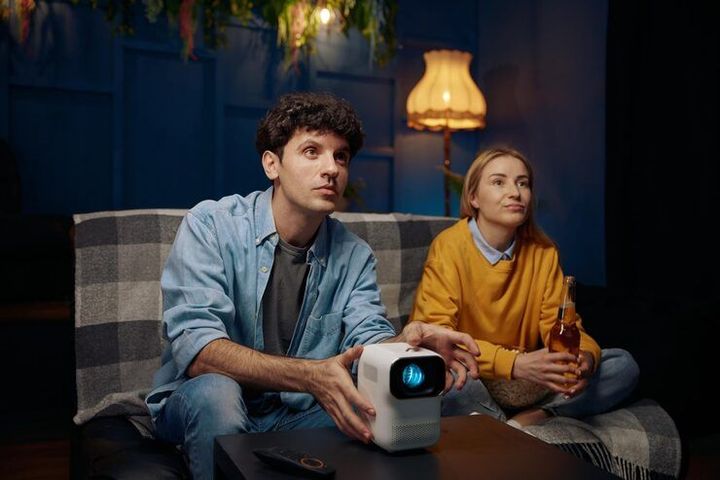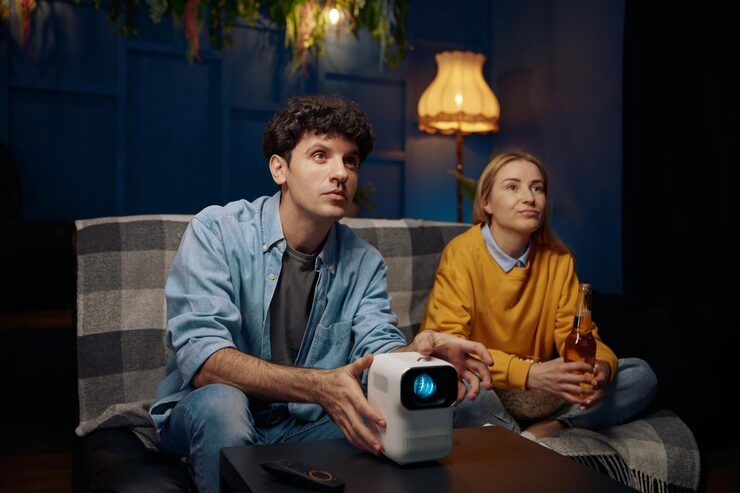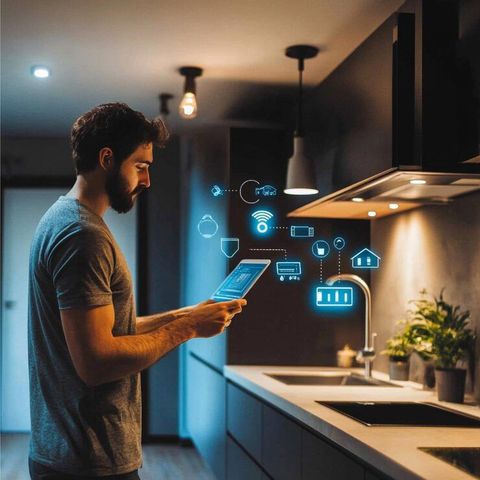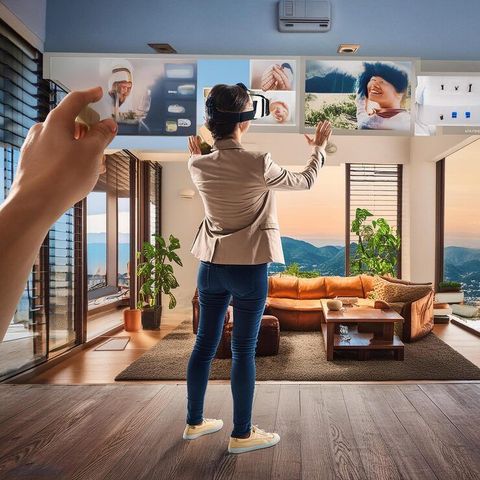
Home Projectors Explained Complete Guide to Features, Setup & Smart Display Technology
Home projectors have transformed the way people experience visual entertainment at home. Instead of relying solely on televisions, projectors allow users to enjoy a cinematic experience on large screens in living rooms, home theaters, or outdoor spaces. These devices work by projecting digital images onto a flat surface, creating immersive viewing for movies, sports, presentations, or gaming.
Modern home projectors use advanced technologies such as DLP (Digital Light Processing), LCD (Liquid Crystal Display), and Laser Projection. Each technology offers different advantages in brightness, color accuracy, and energy efficiency. With resolutions reaching up to 4K UHD and HDR compatibility, projectors have become essential components of today’s home entertainment systems and smart home devices.

Home projectors exist to bring flexibility, portability, and scalability to entertainment. From compact portable models to high-end ceiling-mounted systems, they adapt to different environments and usage needs.
The Growing Importance of Home Projectors Today
In today’s digital lifestyle, home projectors have become more than just optional gadgets — they are part of a broader trend toward immersive visual experiences. Streaming platforms, smart devices, and gaming systems have all fueled the demand for larger, sharper, and more adaptable display solutions.
Key reasons why home projectors matter today include:
-
Enhanced viewing experience: Delivers cinematic quality visuals at home.
-
Smart integration: Many models connect with Wi-Fi, Bluetooth, Alexa, and Google Assistant, fitting into modern smart homes.
-
Educational and remote work use: Ideal for online classes, video conferencing, and presentations.
-
Energy efficiency: Laser and LED models consume less energy than traditional TV panels.
-
Adaptability: Portable designs make outdoor movie nights or travel entertainment easier.
According to market insights, global projector usage in homes grew by over 18% in 2024, driven by hybrid work culture and streaming content consumption. These statistics underline the growing preference for projectors as flexible entertainment and productivity tools.
Recent Developments and Trends in Home Projection (2024–2025)
The last two years have seen significant innovation in projector design, image processing, and smart connectivity. Notable trends include:
| Trend | Description | Year Introduced |
|---|---|---|
| Laser Light Engines | Replace traditional bulbs with long-lasting laser sources, offering up to 30,000 hours of use. | 2024 |
| Ultra Short Throw (UST) Projectors | Can project 100-inch images from less than 30 cm away from the wall. | 2023–2024 |
| 4K HDR+ Technology | Delivers improved dynamic contrast and color depth for lifelike visuals. | 2024 |
| Smart OS Integration | Built-in Android TV and voice control support. | 2024 |
| Portable & Mini Projectors | Compact models under 2 kg for mobile users. | 2025 |
Emerging brands are also focusing on AI-based image correction, automatic keystone adjustment, and real-time color calibration. By mid-2025, many models now support 120Hz refresh rates, catering to gamers and sports enthusiasts who demand smooth visuals.
Additionally, eco-friendly manufacturing has become a priority. Projectors now include recyclable materials and low-heat emission designs, aligning with sustainability standards.
Government Regulations, Standards, and Policies
While there are no direct restrictions on owning or using home projectors, several laws and standards guide their manufacturing, safety, and energy use.
In India:
-
Bureau of Indian Standards (BIS) mandates IS 616 certification for all audio-visual devices, including projectors, to ensure electrical safety.
-
Energy Conservation Act (2024 Amendment) encourages labeling for energy-efficient consumer electronics.
-
Digital India Initiative promotes access to smart home technologies, indirectly supporting the adoption of projectors for education and digital learning.
-
Wireless Equipment Rules (2024) regulate Bluetooth and Wi-Fi-enabled projectors to prevent interference with licensed frequency bands.
Globally:
-
FCC (U.S.) and CE (EU) compliance ensure electromagnetic compatibility and user safety.
-
RoHS Directive limits hazardous materials used in projector components.
-
EcoDesign Regulations (Europe, 2025) now require improved power-saving modes for projectors with automatic standby features.
These rules collectively shape a safer, more sustainable, and more efficient projector ecosystem for global consumers.
Tools, Apps, and Resources for Home Projector Users
Here are some reliable tools and platforms that help users choose, install, and optimize their projectors effectively:
| Tool / Resource | Purpose / Functionality |
|---|---|
| ProjectorCentral.com | Offers calculators to determine ideal screen size and throw distance. |
| AVS Forum | Discussion community for projector setup insights and troubleshooting. |
| SmartThings / Google Home | Apps for integrating projectors into smart home ecosystems. |
| Lumens & Distance Calculator | Helps determine optimal brightness for different room sizes. |
| Home Theater Design Tools (Excel / Web) | Layout templates for screen placement, seating, and lighting. |
For ongoing learning, users can explore video tutorials on YouTube EDU, or documentation from manufacturers’ official websites for setup guidance and firmware updates.
Frequently Asked Questions (FAQs)
1. What is the ideal distance between a projector and the screen?
It depends on the projector’s throw ratio. Most standard models require 8–12 feet for a 100-inch image, while Ultra Short Throw projectors can project from just a few inches away.
2. How long do projector lamps or light sources last?
Traditional lamps last around 3,000–5,000 hours, while laser and LED projectors can last up to 25,000–30,000 hours, requiring minimal maintenance.
3. Can projectors work in bright rooms?
Yes. Look for models with at least 3,000 lumens brightness for daylight viewing. Pairing them with ambient light rejecting (ALR) screens can further enhance clarity.
4. What resolution is best for home cinema?
4K UHD projectors offer the highest quality, though 1080p remains sufficient for smaller rooms. HDR support adds depth and color accuracy for a more cinematic effect.
5. Are projectors suitable for gaming?
Yes, especially those with low input lag (under 20ms) and 120Hz refresh rates. Many gaming projectors now support HDMI 2.1 for smoother visuals and faster response.
Final Thoughts on Home Projectors
Home projectors are redefining how entertainment is experienced, merging technology with lifestyle. With innovations like laser light sources, smart connectivity, and 4K HDR projection, users can enjoy theater-quality visuals right from their living spaces.
Understanding the latest features, compliance standards, and setup tools helps ensure a seamless and safe experience. Whether it’s for family movie nights, gaming, or professional use, modern home projectors provide a perfect blend of performance, portability, and smart integration.
By staying updated with trends, respecting energy standards, and using reliable configuration tools, anyone can create a future-ready visual entertainment space in their home.










